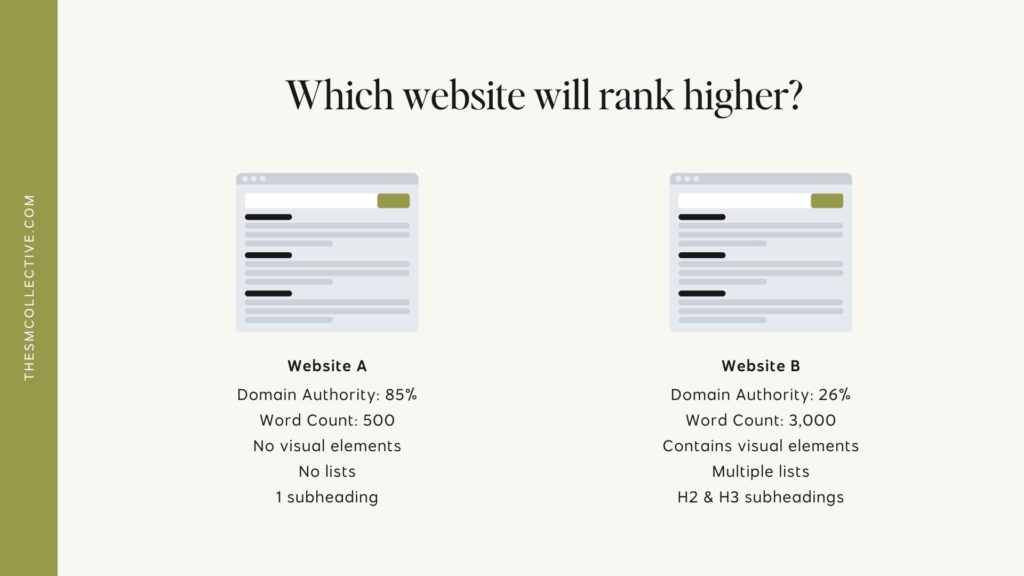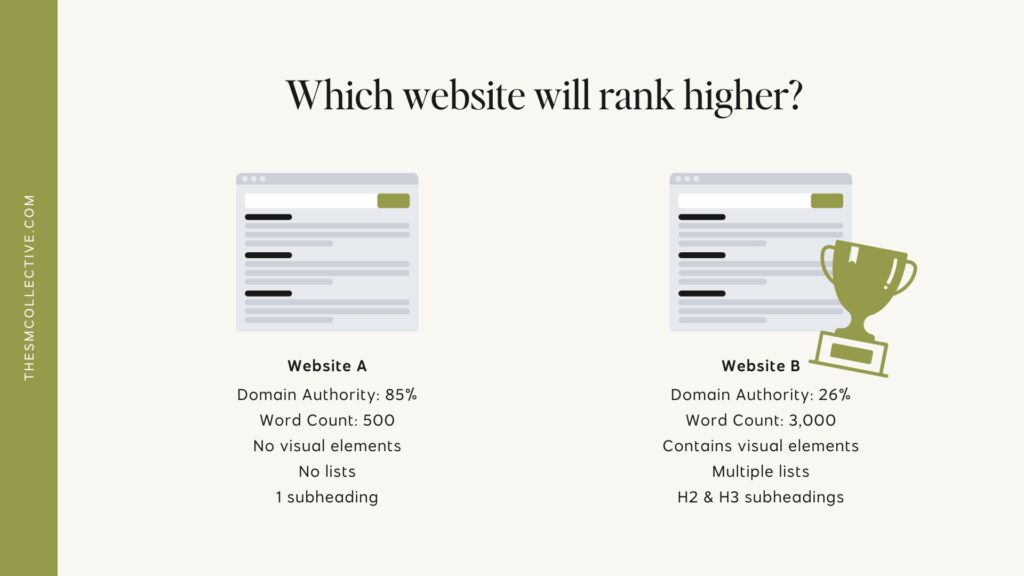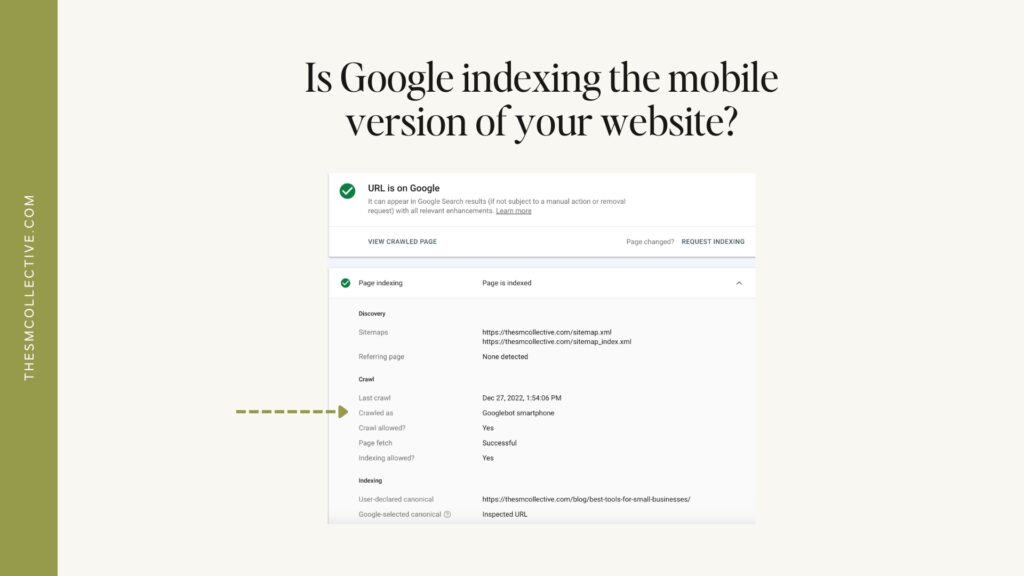With an overabundance of resources, blog posts, YouTube videos, and freebies out there, the number of myths about SEO I see never ceases to amaze me. The SEO myths that people still believe can be quite shocking and there are certainly more than enough misconceptions about SEO out there.
I’m an SEO nerd at heart (that’s a fact). I also love helping others and educating them about the world of SEO (that’s also a fact—and why I created an SEO course).
So if “learn SEO” is at the top of your to-do list for 2025, this post is for you! Here are common SEO myths you should leave behind—and the facts to know instead.
Myths About SEO
SEO Myth #1: SEO is Dead
Alright, we’re just going to get this one out of the way right off the bat. There are rumors going around that SEO is dead.
My response to that: does Google still exist?
Yes, Google still exists.
So no, SEO isn’t dead. (I also wouldn’t be wasting my time writing this blog post on myths about SEO if SEO were dead).
In fact, SEO is booming and we’re seeing it expand behind search engines like Google and Bing. YouTube isn’t just a video platform—it’s a video-based search engine. Pinterest isn’t just a place to save recipes, decorate your dream home, or plan your wedding—it’s a visual search engine.
Even social media platforms like Instagram and TikTok are embodying elements of SEO.
So when someone says SEO is dead, you can quickly tell them that is simply not true. SEO is very much alive and growing every single day.
SEO Myth #2: Google Has a Word Count Guideline
If I had a dollar for every time I saw something about word count guidelines for blog posts, articles, or general pages of a website, I would be a gazillion-trillion-billionaire.
And I’m guessing you’ve heard about word count guidelines, too.
Some say you need at least 300 words on a page. Others say 250 words is fine. Some say your blog posts need to be at least 2,000 words while others say 1,000 words is the goal.
SEO Myth: Google has a word count guideline
SEO Fact: Google doesn’t have a word count guideline
Google’s own John Mueller has even said that Google doesn’t factor in word count, stating:
“From our point of view the number of words on a page is not a quality factor, not a ranking factor. So just blindly adding more and more text to a page doesn’t make it better.”
John Mueller, Google
So let me repeat: Google doesn’t have a word count guideline.
When it comes to word count, you want to focus on quality rather than quantity here. If you can write a really high-quality blog post in 1,000 words…awesome, go for it! If you need 3,000 words to get all of the information in, that’s fine too.
And when it comes to the general pages of your website, the depth and context of it can help guide you. You’ll have 1 primary keyword which is the main keyword you want the page to rank for. You’ll then have a handful of secondary keywords and perhaps even some related keywords as well to expand your ranking opportunities even more.
Let’s take your contact page for example (contact pages are notorious for having a very low word count.) How do you expect to naturally incorporate a primary keyword, 3 secondary keywords, and 2 related keywords into the text on your contact page if you’re only including a quick intro paragraph and a contact form?
It’s quite literally impossible without every single word being one of your keywords…which is spammy and not how people talk.
So although it isn’t a specific word count guideline, you can see from this example that you’re going to need some substance to your pages to incorporate your keywords naturally.
To beef up your contact page, you could add a mini about section, your newsletter sign-up form, a featured blog post section, or perhaps an embedded map section if you have a physical location your customers can visit. Now you have more real estate to work with so that you can naturally incorporate all of those magical keywords.
SEO Myth #3: WordPress is the Best for SEO and Squarespace is the Worst for SEO
I’m just going to get right to it with this one because I see this myth ALLLLLL of the time…
The website platform you use DOES NOT impact your SEO and rankings.
WordPress is not the best for SEO.
Squarespace is not the worst for SEO and Wix is not the worst for SEO either.
So when people ask me, “is Showit good for SEO” or “is Squarespace good for SEO” I always answer with “YES!” Because as you just learned, the website platform you use does not impact your SEO.
What does impact your SEO and rankings…
- Making sure Google knows your site even exists (an intro to another myth we’ll get into soon)
- The keywords you use
- The quality of your content (is it in line with Google’s E-E-A-T Guidelines and Helpful Content System)
- How fast your website loads
- Website security
- The relevancy and usability of a page
- The mobile experience
- Your link structure
…and the list goes on and on. No really, Google has 200+ ranking factors (and the website platform you use isn’t one of them).
SEO Myth #4: Domain Authority is a Google Ranking Factor
Maybe you’ve heard of domain authority, maybe you haven’t. Either way…domain authority isn’t actually a Google ranking factor (surprise!).
Domain authority was initially developed by Moz, a popular SEO software, as a way to signal the likelihood of a website ranking in search results on Google. Moz’s domain authority score ranks websites on a scale from 0 to 100, with 0 being the least likely and 100 being the most likely.
It’s a search engine ranking score—not to be confused with an actual Google ranking factor.
Other SEO platforms followed suit (yes, even popular tech platforms fall into the comparison trap and like to try to one-up each other…sort of like TikTok and Instagram features) and created their own version of domain authority as well…Semrush has authority score, Ahrefs has Ahrefs Rank, etc.
So although domain authority isn’t an actual Google ranking factor, the concept of domain authority and gauging a website’s performance can be used as a guide to know if your website is following basic SEO strategies or not. Instead, focus on creating really high-quality content.
Here’s a quick example to bring this to life…

Website A and website B both have blog posts on “The Basics of SEO.”
Website A has a domain authority of 85% while website B has a domain authority of 26%. The blog post on website A is about 500 words and contains no images, videos, or infographics; it doesn’t include any lists and has just 1 or 2 subheadings.
The blog post on website B is about 3,000 words and contains images, infographics, and has great use of subheadings and lists throughout the post to help make the content skimmable. It also links to other related blog posts as well as some industry-related articles to support the information being shared.
Which website do you think Google will rank higher in search results? Website A with a high domain authority and a low-quality blog post, or website B with a low domain authority and a robust, high-quality blog post?
If you said website B, you are correct! That’s how important having high-quality content is…and how domain authority isn’t truly a ranking factor.

And again I urge you, no matter how hard it may be, to not stress over any sort of domain authority number you may see…because it isn’t an actual ranking factor that Google cares about.
SEO Myth #5: Google Has 2 Indexes
I know words like “index” or “algorithm” can send chills up your spine. But for now, forget any horror stories you’ve heard about algorithms—be it for Instagram or Google—and let’s talk facts for a minute.
Rumor has it that Google has 2 indexes: a desktop index and a mobile index.
Not to burst your bubble, but this is another myth about SEO and Google.
Google has one index that its algorithms use and it’s known as the mobile-first index. The idea that there is a mobile index and a desktop index was a huge misconception when Google first released the mobile-first index.
Google began shifting to mobile-first indexing back in 2016. With the number of mobile users growing, Google’s algorithms were becoming a little less accurate in instances where the mobile site had less content on it than the desktop site.
And now, Google has shifted entirely to mobile-first indexing vs desktop-first indexing as of early 2021. The shift all took place on Google’s end and there was nothing you as a website owner needed to do. And actually, any websites launched after the summer of 2019 were automatically on the mobile-first indexing train.
When it comes to mobile-first indexing, here are some things to keep in mind…
First, you can actually see if Google is indexing the mobile version of your site through Google Search Console. When you’re in your GSC account, enter the URL to one of your website pages into the search bar at the top and hit enter. When the results appear, look for “Crawled As.” If it says “Googlebot smartphone”—that means Google is crawling and indexing your site for mobile-first.

Another key thing to remember when we’re talking about mobile-first indexing—whether you’re building your own website or you’re working with a web designer—is that the user experience on desktop and mobile should be the same.
Let me repeat that—the user experience on mobile and desktop should be the same.
And you might be thinking, “Isn’t that kind of obvious?! It’s the same site!”
And while you aren’t wrong, the problem arises when designers hide or remove desktop elements when it is viewed on a mobile device. Since there is more space to play with on desktop, designers may include more content on desktop than they do on mobile—which can hurt you in the long run.
Google recommends that you focus on making your primary and main content equivalent across desktop and mobile. This not only helps you on the indexing side, but it also creates a seamless user experience.
This is why I strongly advocate for everyone and anyone getting a website built to have an SEO on board. If a web designer is not well-versed in the world of SEO, they may be focused more on the look and aesthetics of the site vs prioritizing the user experience and content for SEO; it needs to be a healthy balance of both.
SEO Myth #6: Google Automatically Knows Your Website Exists
You publish your brand new website or you hit publish on a new blog post and Google just automatically knows it exists and will start ranking it in search results, right?!
Wrong.
Don’t get me wrong, Google is smart—like, really smart. But sometimes Google needs a bit of a nudge or reminder that your site exists.
And how do you let Google know your website exists?
Through an XML sitemap that you can submit in Google Search Console.
(I know that sounds incredibly techy and complicated, but I promise you it isn’t)
So what is an XML sitemap?
An XML sitemap is a file specifically made for search engines like Google that maps out all the pages of your website so that they can crawl and index your pages more easily.
Sitemaps are pretty basic looking—it’s basically just a list with links. But for a simple thing, they are incredibly powerful.
Most website platforms nowadays create a sitemap for you which is great and means there’s no extra work on your end! If you use WordPress for your website or if you use WordPress in conjunction with Showit for your blog, you can get a sitemap made for you using the Yoast SEO plugin, for example.
Now if you’re like me and your website is on Showit and you have the blog integration with WordPress, you’re going to have multiple sitemaps—one for your main Showit site and one for your WordPress blog posts.
Before I switched over to Showit, my site was on Squarespace and I only had one traditional XML sitemap: https://thesmcollective.com/sitemap.xml. So if you’re website is on Squarespace, your sitemap will be in the same format: https://yourwebsitedomainhere.com/sitemap.xml.
Now that my site is on Showit with the WordPress blog integration, my Showit sitemaps look like this:
- https://thesmcollective.com/siteinfo.xml — this is for the main pages of my site that live on Showit
- https://thesmcollective.com/sitemap_index.xml — this is the sitemap for my blog posts that live on WordPress and is created by the Yoast SEO plugin
And if you’re an e-commerce brand or business and you’re using Shopify, your sitemap is also automatically generated for you as well and will look like this: https://yourwebsitedomainhere.com/sitemap.xml.
Now once you have your sitemap or sitemaps created, the next important step is to submit them to Google through a free SEO tool called Google Search Console.
- Sign in to your Google Search Console account
- Select your site from the dropdown in the upper left-hand corner
- Click “Sitemaps” from the navigation pane on the left-hand site. If you don’t see “Sitemaps,” you’ll want to click to expand the “Index” section in the navigation pane to display it
- Enter your sitemap accordingly and don’t forget to include https:// at the beginning or you will see an error message appear
- Click “Submit”
That’s it! It is really that easy to submit your sitemap to Google.
How To Stop Buying Into SEO Myths
So you’ve learned the myths about SEO and you’re aware of all the common SEO myths you should leave behind. But now what?
With so many SEO resources out there, it can certainly be overwhelming to know what’s a fact and what’s a myth. The good news is, I’ve done the heavy lifting for you! I’ve compiled some easy-to-follow and top resources for you so that you can keep on learning the facts about SEO.
So here’s how to stop buying into SEO myths…
Learn the Basics of SEO
The best place to start is with the basics. Having a solid understanding of the basics of SEO not only helps you understand advanced SEO concepts more easily, but you’ll be able to start debunking SEO myths like a pro.
So if you’re curious about what SEO is, how search engines like Google work, the main types of SEO, and even what ranking factors Google cares about most, you’ll want to check out this basics of SEO blog post that outlines all of that and more.
You can also check out this in-your-inbox guide to the basics of SEO that will take you from S-E-uhhhh to SEO pro in just 5 days! You’ll receive 1 email daily for 5 days that teaches you a basic element of SEO:
- Day 1: The Basics of SEO
- Day 2: E-E-A-T Guidelines & Search Intent
- Day 3: Types of SEO
- Day 4: Page Titles and Descriptions
- Day 5: Keywords x SEO
Keep Learning About SEO
Another easy way to stop buying into SEO myths is to keep learning about SEO. I know, I know…that’s a bit basic of a tip to share. As I said before, there are more than enough resources out there that can teach you about SEO.
I have a ton of SEO blog posts that you can explore as well as other blog posts on content marketing. Some of the top resources I’d recommend helping you continue learning about SEO would be the SEMrush blog, Backlinko SEO Hub, and Search Engine Journal.
And don’t forget to check out Google Search Central as well—because what better way to learn about SEO and stop buying into SEO myths than to hear it from Google itself! They have A TON of documentation, a robust blog, and even a “what’s new” section so that you’re always up-to-date on what’s happening in the world of SEO.
Enroll in an SEO Course
If you’re ready to stop relying on trending audio and truly want to make SEO a priority in 2025, you’ll want to check out The SEO Blueprint™.
This SEO course for beginners doesn’t make you choose between do-it-yourself or done-with-help. With a combination of 12+ self-paced modules and monthly live Q&A sessions, you’ll be able to learn at the pace you’re comfortable with AND get the supplemental support you need from a dedicated mentor. (It’s me. Hi. I’m the mentor, it’s me)
Did you love this post? Share it!
Hey there, I'm Stepf—Google Superfan & Passionate Educator
And the showit website designer and seo strategist you’ve been looking for
Through strategic Showit website design and done-for-you search engine optimization, I work with innovative and creative business owners like you to build magazine-worthy websites that effortlessly attract your ideal client—so much so that they’ll never want to leave.
Get to know me
